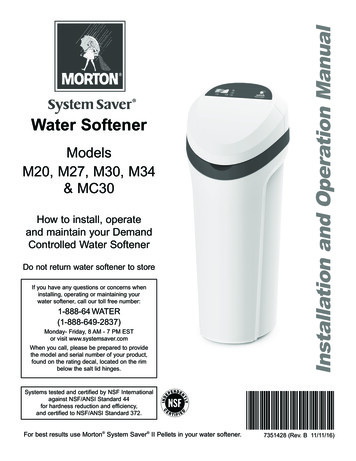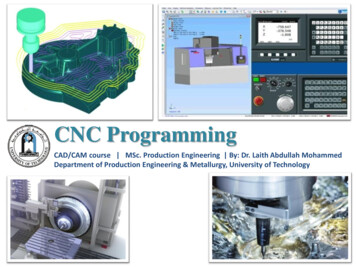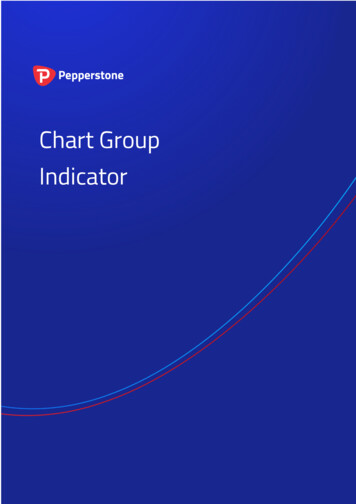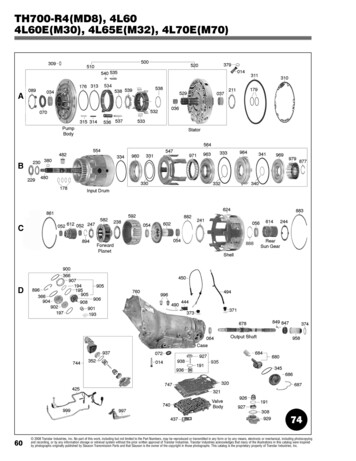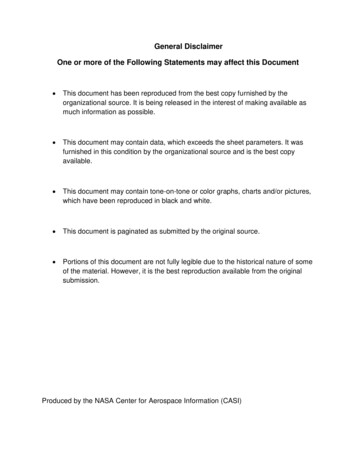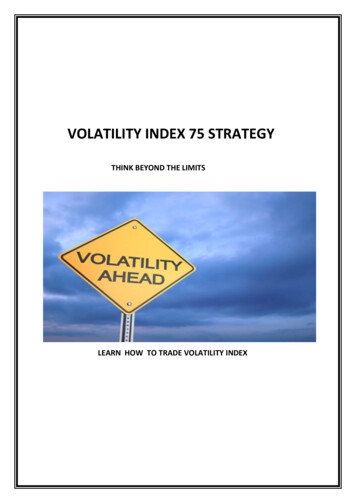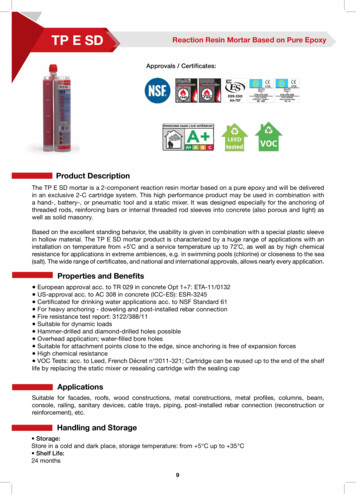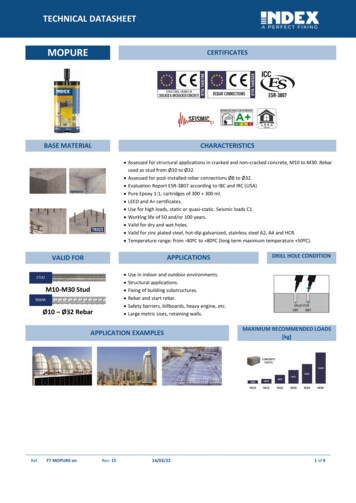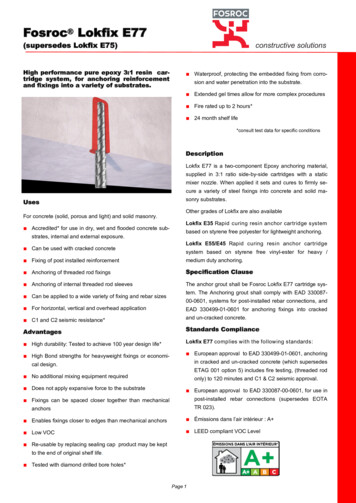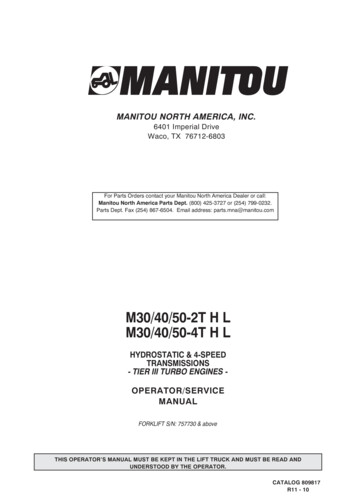
Transcription
CONTENTMANITOU NORTH AMERICA, INC.6401 Imperial DriveWaco, TX 76712-6803For Parts Orders contact your Manitou North America Dealer or call:Manitou North America Parts Dept. (800) 425-3727 or (254) 799-0232.Parts Dept. Fax (254) 867-6504. Email address: parts.mna@manitou.comM30/40/50-2T H LM30/40/50-4T H LHYDROSTATIC & 4-SPEEDTRANSMISSIONS- TIER III TURBO ENGINES OPERATOR/SERVICEMANUALFORKLIFT S/N: 757730 & aboveTHIS OPERATOR’S MANUAL MUST BE KEPT IN THE LIFT TRUCK AND MUST BE READ ANDUNDERSTOOD BY THE OPERATOR.CATALOG 809817R11 - 10
CONTENT
CONTENTM-SERIES TIER IIIFORKLIFT MODEL DESCRIPTIONM 30 -2T H LOPTIONAL CAB HEIGHTS*100 - 100 IN. CAB81 - 81 IN. CAB77 - 77 IN. CABFORKLIFTMODELFORKLIFT RATEDCAPACITY30 - 6,000 LBS40 - 8,000 LBS50 - 10,000 LBS60 - 12,000 LBSDRIVETRAIN-2 - 2WD (2 WHEEL DRIVE)-4 - 4WD (4 WHEEL DRIVE)-T - Turbo Engine (standard)100FRAME LEVELING(Available on 100” Models only)L - FRAME LEVELINGOMITTED - NO LEVELINGFORKLIFTTRANSMISSIONH - HYDROSTATICOMITTED - 4-SPEED/CONVERTERNOTE: Lift trucks equipped with the TIER III Engine have wheels that are painted Manitou silver and the ‘TURBO’ logodisplayed on the fuel tank and hydraulic oil tank.* Dimensions may vary depending on tires, additional options, etc.
CONTENTM- SERIESPOWERTRAIN COMPONENTIDENTIFICATIONTURNER 4--SPEED TRANSMISSIONIDENTIFICATION PLATE(LEFT HAND SIDE OF TRANSMISSION)HYDROSTATIC MOTORIDENTIFICATION PLATE(BOTTOM SIDE OF PUMP)HYDROSTATIC (TRANSMISSION) PUMPIDENTIFICATION PLATE2--SPEED GEARBOX(HYDROSTATIC MODELS)IDENTIFICATION PLATE(BOTTOM SIDE OF PUMP)(RIGHT SIDE OF GEARBOX)MAST SERIAL NO.PLATE(RIGHT SIDE OF MAST)MANUFACTURER’SSERIAL NO.(STAMPED VERTICALLY -FRONT RIGHT SIDE OFFORKLIFT FRAME)MANUFACTURER’SSERIAL NO. PLATEREAR 4WD STEER AXLEIDENTIFICATION PLATE(REAR CENTER, UPPER HALF OFAXLE)(INSIDE THE CAB)ENGINE IDENTIFICATION PLATE(RIGHT HAND SIDE OF ENGINE BLOCK)FRONT DRIVE AXLEIDENTIFICATION PLATE(FRONT CENTER UPPER HALF OFAXLE)
CONTENT- INTRODUCTION TO SAFETY -- ROUGH TERRAIN FORKLIFT TRUCKGENERAL SAFETY STANDARDS - - - - - - - - - - - I- SAFETY MESSAGES - - - - - - - - - - - - - - - - - - - - - - - - - - - - - - - - - - VII- SAFETY DECALS - - - - - - - - - - - - - - - - - - - - - - - - - - - - - - - - - - - - - VIII- TABLE OF CONTENTS - - - - - - - - - - - - - - - - - - - - - - - - - - - - - - - - - XV
CONTENT
CONTENTROUGH TERRAIN FORKLIFT TRUCKGENERAL SAFETY STANDARDSI
CONTENTROUGH TERRAIN FORKLIFT TRUCK GENERAL SAFETY STANDARDSSTUDY THE OPERATOR/SERVICE MANUALSThe information in this manual provides general instructions for the safe operation and maintenance of yourforklift truck. This information is vital and must be clearly understood by the operator and serviceman. Studythis manual and the Rough Terrain Forklift Safety Manual (part no. 422494) thoroughly and carefully beforeoperating or servicing your forklift. Contact your dealer or Manitou North America, Inc. if you have any questions concerning your forklift, its operation, service or parts. Keep both manuals in the literature box on theforklift available for reference. If either manual becomes illegible or is missing, contact your dealer for replacements immediately. This manual cannot cover every situation that might result in an accident. It is the responsibility of the operator to always remain alert for potential hazards and be prepared to avoid them!ADDITIONAL RECOMMENDED LITERATURE:ANSI / ITSDF B56.6 is the national consensus standard for rough terrain forklift trucks. It contains rulesabout forklift safety, maintenance, safe operation, training, and supervision. Forklift owners should learn thisstandard and make it available for their operators, service personnel, and supervisors. These standards canbe obtained, free of charge, from the Industrial Truck Standards Development Foundation (ITSDF) on theirwebsite at www.itsdf.org. The following references are examples from the standard, addressing forklift operators:A.) OPERATOR TRAINING QUALIFICATIONS1.) The user shall ensure that operators understand that safe operation is the operator’s responsibility. Theuser shall ensure that operators are knowledgeable of, and observe, all safety rules and practices.2.) Create an effective operator training program centered around user company’s policies, operating conditions, and rough terrain forklift trucks. The program should be presented completely to all new operators andnot be condensed for those claiming previous experience.3.) Information on operator training is available from several sources, including rough terrain forklift truck manufacturers, users, government agencies, etc.4.) An operator training program should consist of the following:a.) careful selection of the operator, considering physical qualifications, job attitude, and aptitude;b.) emphasis on safety of stock, equipment, operator, and other personnel;c.) citing of rules and why they were formulated;d.) basic fundamentals of rough terrain forklift truck and component design as related to safety, e.g.,in.-lb (N-m) loading, mechanical limitations, center of gravity, stability, etc.;e.) introduction to equipment, control locations, and functions. Explain how they work when usedproperly and problems when used improperly.f.) supervise practice on operating course remote from normal activity and designed to simulateactual operations, e.g., lumber stacking, elevating shingles to the roof, etc.;g.) oral, written, and operational performance tests and evaluations during and at completion of thecourse;h.) refresher courses, which may be condensed versions of the primarycourse, and periodic “on job” operator evaluation;i.) understanding of nameplate data and operator instructions and warning information appearing onthe rough terrain forklift truck.B.) GENERAL SAFETY PRACTICES1.) Rough terrain forklift trucks can cause injury if improperly used or maintained.2.) Only authorized operators trained to adhere strictly to all operating instructions shall be permitted to operaterough terrain forklift trucks. Unusual operating conditions may require additional safety precautions, training,and special operating instructions.3.) Modifications and additions which affect capacity or safe operation shall not be preformed without the manufacturer’s prior written approval. Where such authorization is granted, capacity, operation, and maintenanceinstruction plates, tags, or decals shall be changed accordingly.4.) If the rough terrain forklift truck is equipped with front end attachment(s) or optional forks, the user shall seethat the truck is marked to identify the forks or attachment(s), show the approximate weight of the truck andfork or attachment combination, and show the capacity of the truck with forks or attachment(s) at maximumelevation with load laterally centered.5.) The user shall see that all nameplates and caution and instruction markings are in place and legible.6.) The user shall consider that changes in load dimension may affect rough terrain forklift truck capacity.II
CONTENTROUGH TERRAIN FORKLIFT TRUCK GENERAL SAFETY STANDARDS (cont.)B.) GENERAL SAFETY PRACTICES (cont.)7.) Where steering can be accomplished with either hand and the steering mechanism is of a type that preventsroad reactions from causing the handwheel to spin (power steering or equivalent), steering knobs may be used.When used, steering knobs shall be of a type that can be engaged by the operator’s hand from the top andshall be within the periphery of the steering handwheel.8.) Experience has shown that rough terrain forklift trucks which comply with stability requirements are stablewhen properly operated. However, improper operation, faulty maintenance, or poor housekeeping may contribute to a condition of instability and defeat the purpose of the requirements.9.) Users shall give consideration to special operating conditions. The amount of forward and rearward tilt tobe used is governed by the application. Although the use of maximum rearward tilt is allowable under certainconditions, such as traveling with the load lowered, the stability of a rough terrain forklift truck as determinedby standardized tests does not encompass consideration for excessive tilt at high elevations or the operationof trucks with excessive off-center loads.10.) Some of the conditions which may affect stability are ground and floor conditions, grade, speed, loading(rough terrain forklift trucks equipped with attachments behave as partially loaded trucks even when operatedwithout a load on the attachment), dynamic and static forces, improper tire inflation, and the judgement exercised by the operator.C.) OPERATING SAFETY RULES AND PRACTICES1.) Safe operation is the responsibility of the operator.2.) This equipment can be dangerous if not used properly. The operator shall develop safe working habits andalso be aware of hazardous conditions in order to protect himself, other personnel, the rough terrain forklifttruck, and other material.3.) The operator shall be familiar with the operation and function of all controls and instruments before undertaking to operate the rough terrain forklift truck.4.) Before operating any rough terrain forklift truck, truck operators shall have read and be familiar with theoperator’s manual for the particular truck being operated.5.) Before starting to operate the rough terrain forklift truck:a.) be in operating position and fasten seat belt;b.) place directional controls in neutral;c.) apply brakes;d.) start engine.6.) Do not start or operate the rough terrain forklift truck, any of its functions, or attachments from any placeother than the designated operator’s position.7.) Keep hands and feet inside the operator’s designated area or compartment. Do not put any part of thebody outside the operator compartment of the rough terrain forklift truck.8.) Never put any part of the body into the mast structure or between the mast and the rough terrain forklifttruck.9.) Never put any part of the body within the reach mechanism of the rough terrain forklift truck or other attachments.10.) Understand rough terrain forklift limitations and operate the truck in a safe manner so as not to causeinjury to personnel.11.) Do not allow anyone to stand or pass under the elevated portion of any rough terrain forklift truck, whetherempty or loaded.12.) Do not permit passengers to ride on rough terrain forklift trucks.13.) Check clearance carefully before driving under electrical lines, bridges, etc.14.) A rough terrain forklift truck is attended when the operator is less than 25 ft (7.6m) from the truck, whichremains in his view.15.) A rough terrain forklift truck is unattended when the operator is 25ft (7.6m) or more from the truck, whichremains in his view, or whenever the operator leaves the truck and it is not in his view.16.) Before leaving the operator’s position:a.) bring rough terrain forklift truck to a complete stop;b.) place directional controls in neutral;c.) apply the parking brake;d.) lower load-engaging means fully, unless supporting an occupied elevated platform;e.) stop the engine;f.) if the rough terrain forklift truck must be left on an incline, block the wheels;g.) fully lower the load-engaging means.17.) Maintain a safe distance from the edge of ramps, platforms, and other similar working surfaces.18.) Do no move railroad cars or trailer with a rough terrain forklift truck.III
CONTENTROUGH TERRAIN FORKLIFT TRUCK GENERAL SAFETY STANDARDS (cont.)C.) OPERATING SAFETY RULES AND PRACTICES (cont.)19.) Do not use a rough terrain forklift truck for opening or closing railroad car doors.20.) In areas classified as hazardous, use only rough terrain forklift trucks approved for use in those areas.21.) Report all accidents involving personnel, building structures, and equipment to the supervisor or asdirected.22.) Do not add to, or modify, the rough terrain forklift truck.23.) Do not block access to fire aisles, stairways, and fire equipment.24.) For rough terrain forklift trucks equipped with a differential lock, the lock should not be engaged whendriving on the road or at high speeds or when turning. If the lock is engaged when turning, there could be lossof steering control.25.) Observe all traffic regulations including authorized speed limits. Under normal traffic conditions, keep tothe right, maintain a safe distance, based on speed of travel, from the truck ahead; and keep the truck undercontrol at all times.26.) Yield the right-of-way to pedestrians and emergency vehicles such as ambulances and fire trucks.27.) Do not pass another truck traveling in the same direction at intersections, blind spots, or at other dangerous locations.28.) Slow down and sound the audible warning device(s) at cross-aisles and other locations where vision isobstructed.29.) Cross railroad tracks at an angle wherever possible. Do not park closer than 6 ft (1.8m) to the nearestrail of a railroad track.30.) Keep a clear view of the path of travel and observe other traffic, personnel, and safe clearances.31.) If the load being carried obstructs forward view, travel with the load trailing.32.) Ascend or descend grades slowly and with caution.a.) When ascending or descending grades in excess of 5%, loaded rough terrain forklift trucksshould be driven with the load upgrade.b.) Unloaded rough terrain forklift trucks should be operated on all grades with the load-engagingmeans downgrade.c.) On all grades, the load and load-engaging means shall be tilted back, if applicable, and raisedonly as far as necessary to clear the road surface.d.) Avoid turning, if possible, and use extreme caution on grades, ramps, or inclines; normallytravel straight up or down.33.) Under all travel conditions, operate the rough terrain forklift truck at a speed that will permit it to be broughtto a stop in a safe manner.34.) Travel with load-engaging means or load low and, where possible, tilted back. Do not elevate the loadexcept during stacking.35.) Make starts, stops, turns, or direction reversals in a smooth manner so as not to shift load and/or overturnthe rough terrain forklift truck.36.) Do not indulge in stunt driving or horseplay.37.) Slow down for wet and slippery surfaces.38.) Before driving over a dockboard or bridge plate, be sure that it is properly secured. Drive carefully andslowly across the dockboard or bridge plate, and never exceed its rated capacity.39.) Do not drive rough terrain forklift trucks onto any elevator unless specifically authorized to do so. Approachelevators slowly, and then enter squarely after the elevator car is properly leveled. Once on the elevator, neutralize the controls, shut off engine, and set brakes. It is advisable that all other personnel leave the elevatorbefore truck is allowed to enter or leave.40.) Avoid running over loose objects on the roadway surface.41.) When negotiating turns, reduce speed to a safe level, and turn steering handwheel in a smooth sweeping motion. Except when maneuvering at a very low speed, turn the steering handwheel at a moderate, evenrate.42.) Use special care when traveling without load, as the risk of lateral overturning is greater.43.) Improper use of stabilizer controls (if so equipped) could cause rough terrain forklift truck upset. Alwayslower the carriage before operating stabilizer controls.44.) For rough terrain forklift trucks equipped with lateral leveling:a.) Always level the frame before raising the boom or mast, with or without a load.b.) Lateral leveling should not be used to position an elevated load; instead, lower the load andreposition the rough terrain forklift truck.45.) Handle only stable or safely arranged loads.a.) When handling off-center loads which cannot be centered, operate with extra caution.b.) Handle only loads within the capacity of the rough terrain forklift truck.c.) Handle loads exceeding the dimensions used to establish rough terrain forklift truck capacityIV
CONTENTwith extra caution. Stability and maneuverability may be adversely affected.ROUGH TERRAIN FORKLIFT TRUCK GENERAL SAFETY STANDARDS (cont.)C.) OPERATING SAFETY RULES AND PRACTICES (cont.)46.) When attachments are used, extra care shall be taken in securing, manipulating, positioning, and transporting the load. Operate rough terrain forklift trucks equipped with attachments as partially loaded truckswhen not handling a load.47.) Completely engage the load with the load-engaging means. Fork length should be at least two-thirds ofload length. Where tilt is provided, carefully tilt the load backward to stabilize the load. Caution should beused in tilting backward with high or segmented loads.48.) Use extreme care when tilting load forward or backward, particularly when high tiering. Do not tilt forwardwith load-engaging means elevated except to pick up or deposit a load over a rack or stack. When stackingor tiering, use only enough backward tilt to stabilize the load.49.) The handling of suspended loads by means of a crane arm (boom) or other device can introduce dynamicforces affecting the stability of a rough terrain forklift truck. Grades and sudden starts, stops, and turns cancause the load to swing and create a hazard if not externally stabilized. When handling suspended loads:a.) do not exceed the truck manufacturer’s capacity of the rough terrain forklift truck as equippedfor handling suspended loads.b.) only lift the load vertically and never drag it horizontally;c.) transport the load with the bottom of the load and the mast as low as possible;d.) with load elevated, maneuver the rough terrain forklift truck slowly and cautiously, and only tothe extent necessary to permit lowering to the transport position;e.) use tag lines to restrain load swing whenever possible.50.) At the beginning of each shift and before operating the rough terrain forklift truck, check its condition,giving special attention to:a.) tires and their inflation pressureb.) warning devicesc.) lightsd.) lift and tilt systems, load-engaging means, chains, cables, and limit switchese.) brakesf.) steering mechanismg.) fuel system(s)51.) If the rough terrain forklift truck is found to be in need of repair or in any way unsafe, or if it contributes toan unsafe condition, the matter shall be reported immediately to the user’s designated authority, and the truckshall not be operated until it has been restored to safe operating condition.52.) If during operation the rough terrain forklift truck becomes unsafe in any way, the matter shall be reportedimmediately to the user’s designated authority, and the truck shall not be operated until it has been restoredto safe operating condition.53.) Do not make repairs or adjustments unless specifically authorized to do so.54.) When refueling, smoking in the area shall not be permitted, the engine shall be stopped, and the operatorshall not be on the rough terrain forklifttruck.55.) Spillage of oil or fuel shall be carefully and completely absorbed or evaporated and fuel tank cap replacedbefore restarting engine.56.) Do not use open flames when checking electrolyte level in storage batteries, liquid level in fuel tanks, orthe condition of LPG fuel lines and connectors.57.) Do not lift personnel with the forklift. If the forklift must be used to lift people, precautions for the protectionof the personnel must be taken (see ITSDF B56.6, chapter 5.15 Elevating Personnel).V
ROUGH TERRAIN FORKLIFT TRUCK GENERAL SAFETY STANDARDS (cont.)D.) SUSPENDED LOADSA jib or truss boom should ONLY be used to lift and place loads when the machine is stationary and the frameis level. Transporting suspended loads must ALWAYS be done slowly and cautiously, with the boom and loadas low as possible. Use taglines to restrict loads from swinging, to avoid overturn.The handling of suspended loads by means of a truss boom or other similar device can introduce dynamicforces affecting the stability of the machine that are not considered in the stability criteria of industry teststandards. Grades and sudden starts, stops and turns can cause the load to swing and create a hazard.Guidelines for “Free Rigging / Suspended Loads”1.DO NOT exceed the rated capacity of the telescopic handler as equipped for handling suspendedloads. The weight of the rigging must be included as part of the load.2.During transport, DO NOT raise the load more than 12 inches (305 mm) above the ground, or raisethe boom more than 45 degrees.3.Only lift the load vertically – NEVER drag it horizontally.4.Use multiple pickup points on the load when possible. Use taglines to restrain the load from swingingand rotating.5.Start, travel, turn and stop SLOWLY to prevent the load from swinging. DO NOT exceed walkingspeed.6.Inspect rigging before use. Rigging must be in good condition and in the U.S. comply with OSHAregulation §1910.184, “Slings,” or §1926.251, “Rigging equipment for material handling.”7.Rigging equipment attached to the forks must be secured such that it cannot move either sideways orfore and aft. The load center must not exceed 24 inches (610 mm).8.DO NOT lift the load with anyone on the load, rigging or lift equipment, and NEVER lift the load overpersonnel.9.Beware of the wind, which can cause suspended loads to swing, even with taglines.10.DO NOT attempt to use frame-leveling to compensate for load swing.WARNINGU.S. OSHA regulations effective November 8, 2010 (29 CFR Part 1926, Subpart CC - Cranes and Derricks inConstruction) include requirements for employers that use powered industrial trucks ("forklifts") configuredto hoist (by means of a winch or hook) and move suspended loads horizontally. In particular, this regulationapplies to any rough-terrain forklift (e.g., "telescopic handler") equipped with a jib or truss boom with ahook (with or without a winch), or a hook assembly attached to the forks. [Note: This regulation is inaddition to the OSHA regulation that requires specific forklift operator training: §1910.178(l).]When a forklift / telescopic handler is configured and used for hoisting, the employer must ensure that:1.Forklift, lift equipment and rigging have been inspected (each shift, month and year) and are ingood, safe condition and properly installed.2.An operator's manual and applicable load charts are on the forklift.3.Work zone ground conditions can support the equipment and load. Any hazardous conditions in thework area have been identified, and the operator notified.4.Equipment is being used within its rated capacity and in accordance with the manufacturer'sinstructions.vi
5.Operator and crew members have been trained in the safe use and operation of the equipment,including how to avoid electrocution.6.During use, no part of the equipment, load line or load will be within the minimum clearancedistance specified by OSHA [10 feet (3.0 m), and more for lines rated over 50 kV] of any energizedpower line, and any taglines used are non-conductive.7.In addition, for lift equipment with a rated capacity greater than 2000 lbs. (907 kg), the employermust ensure that:a.) An accessible fire extinguisher is on the forklift;b.) Monthly and annual inspections are performed and documented, and records retained (threemonths for monthly, one year for annual);c.) Before November 10, 2014, operators must have had the additional training and qualification /certification required by OSHA regulations §1926.1427 and §1926.1430.Note: Refer to the full text of the OSHA crane regulation (29 CFR Part 1926, Subpart CC) for a detaileddescriptionvii
ROUGH TERRAIN FORKLIFT TRUCK GENERAL SAFETY STANDARDS (cont.)CONCLUSION:1.) ATTEND OPERATOR TRAINING CLASSESThe forklift operator must clearly understand all instructions concerning the safe operation of the forklift and allsafety rules and regulations of the work site. They must have successfully completed a training coarse inaccordance with the Powered Industrial Truck Standard (29 CFR 1910.178) as described by the OccupationalSafety and Health Administration (OSHA). They must be qualified as to their visual, hearing, physical, andmental ability to operate the equipment safely. NEVER use drugs or alcohol while operating a forklift! NEVERoperate or allow anyone to operate a forklift when mental alertness or coordination is impaired! An operatoron prescription or over-the-counter drugs must consult a medical professional regarding any side effects of themedication that may impair their ability to safely operate the forklift.2.) CREATE A MAINTENANCE PROGRAMOSHA recommends a maintenance log, listing repairs requested and completed, for each forklift. Also, “lockout tag procedures” should be utilized. If the forklift malfunctions; park it safely, remove the key, tag “Do NotUse”, and report the problem to the proper authority or authorized service personnel immediately.ROUGH TERRAIN FORKLIFT TRUCK GENERAL SAFETY STANDARDS (cont.)2.) CREATE A MAINTENANCE PROGRAM (cont.)For the best forklift performance and operation, a maintenance program is required. Use the hour meter onthe instrument panel to keep maintenance properly scheduled (see SECTION TWO - “Servicing Schedule”).For repairs on major components (engine, transmission, etc.), contact your nearest dealer for a Repair Manual.Do not operate a forklift that is damaged or does not function properly. Only authorized personnel may makerepairs or adjustments to the lift truck. After repairs, the lift truck must be tested for safe operation beforereturning to service.3.) FORKLIFT KNOWLEDGEForklift trucks can cause serious injury if improperly used or maintained. Study all of the manuals provided foryour forklift model. Learn the locations and meanings of all safety decals. If any decals are illegible or missing, have them replaced immediately. Make sure all safety features provided by the original manufacturer arein place and function properly. Do not operate a forklift with damaged, missing or unsafe components. Haveit repaired by authorized service personnel. Learn the functions of all controls, gauges, indicator lights, etc. onthe forklift. Know the speed/gear ranges, braking and steering capabilities, load ratings and clearances. Whenreferring to the location of forklift components, the terms “left”, “right”, “front”, and “rear” are related to the operator seated normally, facing forward in the operator’s seat. If you have any questions about the forklift, consult your supervisor. Failure to fully understand or obey safety warnings can result in serious injury or death!4.) WORK SITE KNOWLEDGEBefore operating on a work site, learn the rules for movement of people, forklifts and all other traffic. Checkthe size, weight, and condition of the loads you will be expected to handle. Verify that they are properlysecured and safe to transport. Learn where the loads are to be placed, planning your route for a safeapproach, watching for hazardous conditions. Will a signal man be required to help place the load? Removeany debris which may cause tire damage or rupture. Plan your route around problem areas or have them corrected. Inform the supervisor of any unsafe conditions observed at the site. Examples of hazards: powerlines, cables, low clearance structures, garage doors, telephone pole guide lines, fencing, loose lumber, building materials, drop-offs, trenches, rough/soft spots, oil spills, deep mud, steep inclines, railroad tracks, curbs,etc. NEVER approach power lines, gas lines or other utilities with the forklift! Always verify that local,state/provincial and federal regulations have been met. Report any accidents involving personnel, buildingstructures, and equipment to the supervisor immediately. Always remain alert - conditions are constantlychanging at the work site!TECHNICAL SUPPORTAll data provided in this manual is subject to production changes, addition of new models, and improved product designs. If a question arises regarding your forklift, please consult your dealer or K-D Manitou, Inc. for thelatest information. When ordering service parts or requesting technical information, be prepared to quote theapplicable Model/Serial Numbers.viii
SAFETY MESSAGESNOTE THE SAFETY ALERT SYMBOL (SHOWN BELOW). IT IDENTIFIES POTENTIALHAZARDS WHICH, IF NOT AVOIDED MAY RESULT IN INJURY OR DEATH! Also, observethe safety messages places throughout this manual; providing special instructions, telling you when to take precautionsand to identify potential hazards. The safety messages are highlighted and outlined in a box similar to those shown in theexamples below.SAFETY ALERT SYMBOLNOTE or NOTICEProvides information, special instructions or references about the lift truck.IMPORTANTPrecautions which must be taken to avoid damage to the lift truck.CAUTIONIndicates a potentially hazardous situation which, if not avoided, may result in minor ormoderate injury. May also alert unsafe practices.WARNINGIndicates a potentially hazardous situation which, if not avoided, may result in death orserious injury!DANGERIndicates an imminently hazardous situation which, if not avoided, will result in death orserious injury.CALIFORNIA PROPOSITION 65 WARNINGDiesel Engine Exhaust and some of its constituents are known to the State of Californiato cause cancer, birth defects or other reproductive harm.WARNING: Battery posts, terminals and related accesories and related accessoriescontain lead and lead compounds. Wash hands after handling.ix
CONTENTSAFETY DECALSThe purpose of this chapter is to introduce you to the safety messages, decals, and nameplates found onyour forklift truck. The decals are identified by name, part number, location, and a brief description. (Theforklift model logos, and other misc. decals not shown, can be found in your forklift parts manual.) Thedecals illustrated may not be exactly the same as those installed on your forklift; installation of the decalsvaries depending on the forklift model, series, decal updates, etc. The size and location of some decalslimit the amount of information that can be placed upon it. For this reason, additional de
8.) Never put any part of the body into the mast structure or between the mast and the rough terrain forklift truck. 9.) Never put any part of the body within the reach mechanism of the rough terrain forklift truck or other attach-ments. 10.) Understand rough terrain forklift limitations and operate the truck in a safe manner so as not to cause

